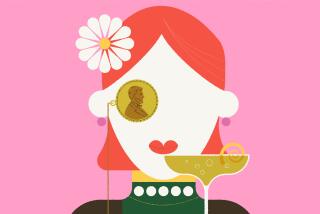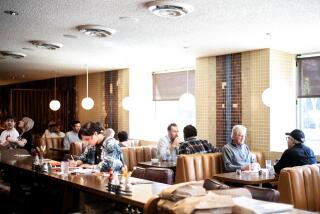Nairobi Bustles With Beauty, Romance and a Still-Exotic Aura
- Share via
NAIROBI, Kenya — Once a haven for British remittance men, European adventurers with checkered pasts and other less-than-sterling types, this city still has the faintly exotic aura of an East African outpost for dissolute Continentals and characters out of a Joseph Conrad novel.
Yet from its birth 80 years ago as a small station on the Mombasa-Uganda railway, then through an era of British colonialism that ended with independence in 1963, Nairobi has grown and prospered into a beautiful and energetic city, the largest between Cairo and Johannesburg.
But with all its new hotels and striking contemporary architecture, Nairobi still has that romantic, east-of-Suez feeling, with vendors roasting corn on the streets, thorn trees and bougainvillea everywhere, and old East African hands gathering for a sundowner on the Norfolk Hotel’s lovely terrace to hash over colonial days.
The blend of today’s bustling with nostalgic yesteryear sets a mood that is definitely catching.
Here to there: Fly British Airways, KLM, Pan Am, Lufthansa or Air France, all with European stops.
How long/how much? Give the city a couple of days, perhaps another for activities outside town (see below). Lodging costs run the gamut, with very good hotels in the moderate range. Dining well is inexpensive to moderate, particularly in Indian places.
A few fast facts: The Kenyan shilling recently traded at 17 to the U.S. dollar, about 6 cents each. Rainy season is March through May and November-December, the latter months mostly being short rains. You must have a visa, and put aside $10 in green for the departure tax. No shots are required, but it makes sense to have them for yellow fever, cholera and typhoid, with a malaria-pill series also a good idea if you’re going into the countryside. Good selection of safari gear at Banana Republic here, or at stores and hotel shops in Nairobi.
Getting settled: Panafric Hotel (Milimani Road; $75 double B&B;) is a large, modern and cool place set in a sea of flowering bougainvillea. Neat and colorful rooms with small balconies, some overlooking a pool, others with fine views. Handsome indoor-outdoor terrace restaurant for lunch or four-course dinner, which was about $9.
New Stanley Hotel (Kenyatta Ave.; $97 double) has been a part of the town’s history since 1907 and still has a certain mystique. Alas, the famous Long Bar is no more, but the Thorn Tree Cafe is famous throughout Africa as a meeting place and message center. Every Wednesday there’s an African food buffet in the dining room.
Two in the budget range are Sagret (Milimani Road; $40 B&B; double) and the very central Hermes (Haile Selassie Ave.; $27 B&B; double). Both are very neat and clean, the former with an outdoor nyama choma (African-style barbecue), the latter serving a fantastic Indian buffet lunch daily for $3.50.
Regional food and drink: While true African dishes aren’t that easy to come by in bigger hotels, you might find one or two typical specialties on the menu or buffet. Look for ugali , a thick maize porridge usually served with meat or a stew. Irio , a mix of beans, maize and potatoes cooked together and then mashed, is a traditional Kikuyu tribal meal, again served with various meats or chicken.
Mbavu za mbuzi is a plate of mutton ribs seasoned with pepper, tomatoes and onions and served with a salad. And muteta soup is a hearty bouillon loaded with herbs.
Tusker beer is not only excellent but the price is controlled all over Kenya at a bargain rate. Papaya wine was new to us and, well chilled, very pleasant.
Moderate-cost dining: Carnivore, near the airport, is the one place everyone seems to hit. For $12 per person you sit under rustic thatch in a flowery patio and keep downing a variety of barbecued meats as long as you can. The usual beef, lamb, pork and chicken, but there are always three or four really wild offerings. We had the crocodile, impala and camel. You also get soup, a variety of salads and a choice of excellent desserts.
Nairobi has wonderful Indian restaurants, one of the best being Minar on Banda Street, where the food is Mughlai tandoori, with specialties from other parts of India. We ate like Akbar the Great for a couple of hours, washed it all down with several Tuskers and the tab was under $16 for two. The Kashmiri roganjosh was heavenly, as was the boti barra kabob--mutton marinated overnight in yogurt and spices, then broiled in a tandoori.
African Heritage Cafe (on Banda Street just off Kenyatta Avenue) has a fine selection of Kenyan specialties. It’s connected to the African art and artifacts shop of the same name, the very best place in town to do your shopping, with absolutely exquisite pieces at every price level. The cafe has both a Kenyan and Ethiopian buffet at lunch and dinner, each a real adventure.
Going first-class: The Norfolk Hotel (Harry Thuku Road; $106 double) has been a part of Kenya’s history since its opening in 1904, a Tudor landmark that still sprays a feeling of empire. The Ibis Grill is noted for its fine food and chic diners, while the Delamere terrace and bar is the place to see and be seen.
Nairobi Safari Club (University Way; $145 double, all suites) is a new and sparkling addition to mid-town, managed by Inter-Continental hotels. It has every possible amenity of a big-city hotel: pool, sauna, gym, et al. The suites are spacious and comfortable and the breakfast buffet is a real spread.
On your own: Take the short drive outside town to the Bomas of Kenya Cultural Center for a program of native songs and dances in a huge “tribal hut.” There’s also a native village there with a dozen homesteads typical of all parts of Kenya.
Nairobi National Park, five miles from town, is also open daily, a drive-through mini-safari for viewing lions, hippos, rhinos, giraffes, cheetahs, crocodiles and many other animals. Part of the park is an animal orphanage, the baby wart hogs still as cute as on our last visit.
Don’t miss a visit to the mid-town municipal market, where, if you bargain well (about 25% below asking price), you’ll pick up very handsome artifacts for a pittance. And the home of Karen Blixen, whose writings were the basis for the movie “Out of Africa,” is now run as a museum. If you enjoyed the movie or Blixen’s other published work, you might want to make this pilgrimage.
For more information: Call the Kenya Tourist Office at (213) 274-6635, or write (9100 Wilshire Blvd., Suite 111, Beverly Hills 90212).
More to Read
Sign up for The Wild
We’ll help you find the best places to hike, bike and run, as well as the perfect silent spots for meditation and yoga.
You may occasionally receive promotional content from the Los Angeles Times.






